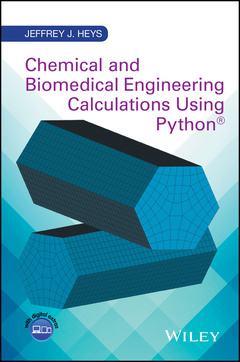Chemical and Biomedical Engineering Calculations Using Python
Auteur : Heys Jeffrey J.

Presents standard numerical approaches for solving common mathematical problems in engineering using Python.
- Covers the most common numerical calculations used by engineering students
- Covers Numerical Differentiation and Integration, Initial Value Problems, Boundary Value Problems, and Partial Differential Equations
- Focuses on open ended, real world problems that require students to write a short report/memo as part of the solution process
- Includes an electronic download of the Python codes presented in the book
Preface xi
About the Companion Website xv
1 Problem Solving in Engineering 1
1.1 Equation Identification and Categorization 4
1.1.1 Algebraic versus Differential Equations 4
1.1.2 Linear versus Nonlinear Equations 5
1.1.3 Ordinary versus Partial Differential Equations 6
1.1.4 Interpolation versus Regression 8
Problems 10
Additional Resources 11
References 11
2 Programming with Python 12
2.1 Why Python? 12
2.1.1 Compiled versus Interpreted Computer Languages 13
2.1.2 A Note on Python Versions 14
2.2 Getting Python 15
2.2.1 Installation of Python 17
2.2.2 Alternative to Installation: SageMathCloud 18
2.3 Python Variables and Operators 19
2.3.1 Updating Variables 21
2.3.2 Containers 23
2.4 External Libraries 25
2.4.1 Finding Documentation 27
Problems 28
Additional Resources 29
References 30
3 Programming Basics 31
3.1 Comparators and Conditionals 31
3.2 Iterators and Loops 34
3.2.1 Indentation Style 39
3.3 Functions 39
3.3.1 Pizza Example 43
3.3.2 Print Function 44
3.4 Debugging or Fixing Errors 45
3.5 Top 10+ Python Error Messages 45
Problems 47
Additional Resources 49
References 49
4 External Libraries for Engineering 51
4.1 Numpy Library 51
4.1.1 Array and Vector Creation 51
4.1.2 Array Operations 55
4.1.3 Getting Helping with Numpy 55
4.1.4 Numpy Mathematical Functions 56
4.1.5 Random Vectors with Numpy 57
4.1.6 Sorting and Searching 57
4.1.7 Polynomials 58
4.1.8 Loading and Saving Arrays 59
4.2 Matplotlib Library 60
4.3 Application: Gillespie Algorithm 63
Problems 66
Additional Resources 68
References 68
5 Symbolic Mathematics 70
5.1 Introduction 70
5.2 Symbolic Mathematics Packages 71
5.3 An Introduction to SymPy 72
5.3.1 Multiple Equations 75
5.4 Factoring and Expanding Functions 76
5.4.1 Equilibrium Kinetics Example 77
5.4.2 Partial Fraction Decomposition 78
5.5 Derivatives and Integrals 78
5.5.1 Reaction Example 79
5.5.2 Symbolic Integration 80
5.5.3 Reactor Sizing Example 80
5.6 Cryptography 81
Problems 83
References 86
6 Linear Systems 87
6.1 Example Problem 88
6.2 A Direct Solution Method 91
6.2.1 Distillation Example 95
6.2.2 Blood Flow Network Example 95
6.2.3 Computational Cost 98
6.3 Iterative Solution Methods 100
6.3.1 Vector Norms 100
6.3.2 Jacobi Iteration 100
6.3.3 Gauss–Seidel Iteration 103
6.3.4 Relaxation Methods 105
6.3.5 Convergence of Iterative Methods 105
Problems 107
References 112
7 Regression 113
7.1 Motivation 113
7.2 Fitting Vapor Pressure Data 114
7.3 Linear Regression 115
7.3.1 Alternative Derivation of the Normal Equations 118
7.4 Nonlinear Regression 119
7.4.1 Lunar Disintegration 122
7.5 Multivariable Regression 126
7.5.1 Machine Learning 127
Problems 129
References 134
8 Nonlinear Equations 135
8.1 Introduction 135
8.2 Bisection Method 137
8.3 Newton’s Method 140
8.4 Broyden’s Method 143
8.5 Multiple Nonlinear Equations 146
8.5.1 The Point Inside a Square 149
Problems 151
9 Statistics 156
9.1 Introduction 156
9.2 Reading Data from a File 156
9.2.1 Numpy Library 157
9.2.2 CVS Library 159
9.2.3 Pandas 159
9.2.4 Parsing an Array 162
9.3 Statistical Analysis 162
9.4 Advanced Linear Regression 164
9.5 U.S. Electrical Rates Example 168
Problems 172
References 175
10 Numerical Differentiation and Integration 176
10.1 Introduction 176
10.2 Numerical Differentiation 176
10.2.1 First Derivative Approximation 177
10.2.2 Second Derivative Approximation 180
10.2.3 Scipy Derivative Approximation 181
10.3 Numerical Integration 183
10.3.1 Trapezoid Rule 185
10.3.2 Numerical Integration Using Scipy 186
10.3.3 Error Function 187
Problems 190
Reference 192
11 Initial Value Problems 193
11.1 Introduction 193
11.2 Biochemical Reactors 193
11.3 Forward Euler 195
11.4 Modified Euler Method 198
11.5 Systems of Equations 199
11.5.1 The Lorenz System and Chaotic Solutions 200
11.5.2 Second-Order Initial Value Problems 203
11.6 Stiff Differential Equations 203
Problems 206
References 210
12 Boundary Value Problems 211
12.1 Introduction 211
12.2 Shooting Method 212
12.3 Finite Difference Method 216
12.3.1 Reactions in Spherical Catalysts 220
Problems 224
Reference 226
13 Partial Differential Equations 227
13.1 Finite Difference Method for Steady-State PDEs 227
13.1.1 Setup 228
13.1.2 Matrix Assembly 230
13.1.3 Solving and Plotting 232
13.2 Convection 233
13.3 Finite Difference Method for Transient PDEs 236
Problems 241
Reference 244
14 Finite Element Method 245
14.1 A Warning 245
14.2 Why FEM? 246
14.3 Laplace’s Equation 246
14.3.1 The Mesh 246
14.3.2 Discretization 247
14.3.3 Wait! Why Are We Doing This? 248
14.3.4 FEniCS Implementation 248
14.4 Pattern Formation 249
Additional Resources 253
References 254
Index 255
Jeffrey J. Heys is currently the department head in Chemical and Biological Engineering at Montana State University. He has taught numerous courses in Chemical and Biological Engineering for 15 years. He also taught courses in Applied Mathematics at the University of Colorado at Boulder, including Numerical Analysis, for three years. Jeff has been creating mathematical models of biological systems for approximately 20 years, published more than 40 peer reviewed papers, and has programmed extensively in FORTRAN, C, C++, MATLAB®, and Python®.
Date de parution : 01-2017
Ouvrage de 288 p.
16x23.6 cm
Thème de Chemical and Biomedical Engineering Calculations Using... :
Mots-clés :
Python programming
